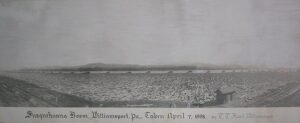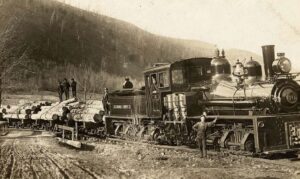Millionaire's Row, Heritage / Our Roots
Millionaire's Row, Heritage / Our Roots
In the 19th century, Pennsylvania’s forests powered a booming industry that left a lasting mark on the landscape and communities of the Lumber Heritage Region. Towering white pines and hemlocks, once stretching unbroken for millions of acres, became the foundation for one of the most significant timber industries in American history. At its height, this lumber boom transformed quiet river towns into bustling industrial centers—none more prominent than Williamsport, Pennsylvania, which earned the title “Lumber Capital of the World.”
At the heart of this transformation was the Susquehanna Boom, a massive system of cribs and chained timbers stretching seven miles along the West Branch of the Susquehanna River. Constructed in 1846, the boom could hold nearly 300 million board feet of logs at once. This ingenious feat of engineering allowed sawmills to operate year-round and turned the river into a conveyor belt of prosperity. Timber harvested upstream in the wilds of Pennsylvania was floated downstream and sorted at the boom, fueling more than 50 sawmills in the Williamsport area alone.

The boom itself was a massive collection of anchored cribs—manmade islands built from stone and timber—linked together to form a holding area for millions of logs floating downriver. This worked like a fence, holding the floating timber in place with minimal disruption to the flow of the river. As timber arrived from upstream, workers known as “boom rats” guided the logs into the structure, where they were sorted by brand and directed to the appropriate mill. Each log was marked with a unique symbol “stamped” into the wood, identifying its owner. This efficient system kept sawmills supplied year-round and allowed Williamsport’s lumber industry to thrive.
The wealth generated during the lumber era was unprecedented. By the late 1800s, Williamsport had more millionaires per capita than anywhere else in the United States. These lumber barons built opulent Victorian mansions along what came to be known as “Millionaires Row.” Today, these homes and the city of Williamsport itself, stand as a testament to the grandeur and ambition of the era, reflecting a time when Pennsylvania lumber helped build the nation’s cities, railroads, and industry.
But with every boom comes a bust. The same aggressive harvesting that made fortunes also stripped the land. By the early 20th century, vast swaths of forests were gone. Hillsides were left bare, rivers clogged with debris, and communities that once thrived began to fade. Wildfires and soil erosion followed the extensive deforestation, causing further duress to the region. The wastelands of the region were nicknamed “The Pennsylvania Desert” and the economy, once built on limitless timber, struggled as mills shut down and workers moved on.

The end of the lumber era forced Pennsylvania to confront the consequences of unchecked resource extraction. Fortunately, this moment of reckoning also sparked one of the nation’s earliest conservation movements. Reforestation efforts, the rise of the Civilian Conservation Corps, and the creation of public lands laid the groundwork for the forests we see today.
The movement to restore Pennsylvania’s forests was led by forward-thinking individuals like Dr. Joseph Rothrock, known as the “Father of Forestry in Pennsylvania,” and Gifford Pinchot, the first Chief of the U.S. Forest Service and later Pennsylvania’s governor. Rothrock championed sustainable forestry practices and helped lay the foundation for the state’s forest management system. Pinchot, a national leader in conservation, expanded these efforts and emphasized public stewardship of natural resources. Both men were instrumental in promoting reforestation, land acquisition, and education.
Their legacy continued during the Great Depression, when Pinchot helped bring President Franklin D. Roosevelt’s Civilian Conservation Corps (CCC) to Pennsylvania. The CCC played a critical role in rebuilding the state’s forests, constructing trails, roads, and fire towers—many of which still serve the region today. Thanks to their leadership, Pennsylvania’s once-denuded hillsides began to heal, creating the second-growth forests that define the Lumber Heritage Region today.
While the days of the Susquehanna Boom are gone, their impact remains embedded in the character of the Lumber Heritage Region. The boom and bust of the lumber era tells a cautionary tale—but also one of resilience, innovation, and rebirth. It’s a story written in the rings of Pennsylvania’s trees and echoed in the communities and industries that continue to honor this rich and complex legacy.
© 2025 Lumber Heritage Region LLC | Website Designed & Hosted by Pixel & Hammer